| Qu1: |
All are C bonds but there are different hybridisations (recall that in terms of size sp3 > sp2) and the aromatic CC has resonance with significant double bond character (hence shortest). (v1=AB, v2 =A) |
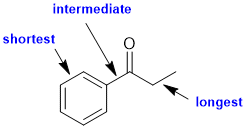 |
| Qu 2: |
Assign the formal charges...N with 2 bonds and 2 lone pairs is -1, N with 3 bonds and N with 4 bonds is +1. A C atom with 3 bonds and a single e is neutral (v1=B, v2=D) |
 |
| Qu 3: |
Basicity...Think about the availability of the electrons in the bases, always a good idea to draw in the lone pairs because lone pairs are more available than bonded pairs. Two N and one O system. sp3 e are less tightly held than sp2, so sp3 N is more basic. O is more electronegative than N so O is less basic than N. (v1=A, v2 = AB) |
|
Qu 4: |
Increased branching = increased stability (due to the presence of more stronger primary C-H bonds). (v1=E, v2 =D) |
 |
| Qu 5: |
The more stable radical can the associated with breaking the weaker C-H to form the radical. So since an sp3 C-H is weaker than sp2 C-H, the vinyl radical is the least stable. The allylic radical is also stablised by resonance. (v1=D, v2 =B) |
 |
| Qu 6: |
Acidity...the structures are an amide NH and CH and an amine NH. Both the amide NH and CH are made more acidic because the H are adjacent to the C=O give the conjugate base where the anion is resonance delocalised to allow the negative charge on to the electronegative oxygen atom (pKa NH about 15, CH about 30). The amine NH has no resonance stabilisation and N has moderate electronegativity (pKa about 35). (v1=A, v2=DA) |
 |
| Qu 7: |
Counting types of H (models lab). Consider C hybridisation, position and symmetry (v1=AB, v2=C) |
 |
| Qu 8: |
Ranking resonance structures...we need to check for complete octets and maximised bonding (within the octet rule limitations) and for charge separation in accord with electronegativity. (v1=D, v2=AB) |
 |
MOLECULAR PROPERTIES:
No real method here, really just do you know various aspects of molecular structure and apply it to the molecule(s) in question. |
| Qu9: |
Basicity...Think about the availability of the electrons in the bases : lone pairs are more available than bonded pairs so N and O are more basic than a C with 4 bonds. Since N is less electronegative than O, lone pairs on N are more available than those on O hence N is more basic than O. N11 is part of an amide and the N lone pair is involved in resonance while N16 is an amine. |
| Qu10: |
N19 is part of a tertiary amine but there is an adjacent pi system so the N is involved in resonance so the N is sp2 hybridised with the lone pair in a p orbital. |
| Qu11: |
O8 is in part of an ester (sp2 hybridisation due to resonance) and O13 is in a simple ether. |
| Qu12: |
IHD ... Carefully work out MF = C15H18N4O5 then use the equation to evaluate IHD = 9 (or, more easily counting from the structure there are 5 pi bonds and 4 rings, 5+4 =9 |
| Qu13: |
O4 and O22 are each part of a ketone, N1 and N16 part of an amine. |
| Qu14: |
Assign the R/S stereochemistry, using the Cahn-Ingold-Prelog rules to assign group priorities because the priority order of attached groups at C12: O13 > N19 > C1 (NCH) > C6 (CCH) ...and when viewing with the C6 (low priority away), the sense is clockwise => R. The alkene C5=C20 the groups are N19 > C21 and C3 (OOC) > C6 (CCH). (v1=A, v2=B) |
| Qu15: |
Since C7 is sp3 and hence tetrahedral, the bond angle will be close to 109.5 degrees. (v1=C, v2=C) |
| Qu16: |
Since C6 is attached to 3 other C atoms, it is tertiary. (v1=CE, v2=AE) |
| Qu17: |
C3 Oxidation states...count the bonds attached to the atom being considered. A bond to a more electronegative atoms counts -1, a bond to the same type of atom counts 0 and a bond to a less electronegative atom (e.g. H) counts +1. Total the count and then consider the formal charge on the central atom since the oxidation state for the central atom plus the groups attached must equal the atoms formal charge. For C3 the C is attached to 2 x C (count 0) and 2 x O (count -2) and therefore total = -2 and therefore the oxidation state C3 = +2. (v1= AC, v2 = C) |
SPECTROSCOPY:
Use the IR spectra provided to get the functional groups that are present in the structures, so look for the key groups : C=O (near 1700 cm-1) , -OH or -NH (above 3000 cm-1), aromatic C=C (two bands 1600-1400 cm-1), C-O (near 1200 cm-1) and triple bonds (near 2200 cm-1).... use the tables as needed. |
| Qu18: |
The IR shows a C=O a little below 1700 cm-1. The IR does not show -OH or -NH, or triple bonds, but maybe C=C near 1600 and 1500 cm-1. This would be consistent with the aromatic ketone. (v1=A, v2=AB) |
 |
| Qu19: |
The IR shows a C=O a little above 1700 cm-1. The IR does not show -OH or -NH, or C=C, or triple bonds, and no C-O but strong sp3CH just below 3000 cm-1. This would be consistent with the ketone. (v1=BC, v2=E) |
 |
| Qu20: |
The IR shows does not have a C=O near 1700 cm-1 nor -OH or -NH but there are absorptions just above and below 3000 cm-1 that indicates sp2 and sp3 CH suggesting an alkene (note symmetrical C=C tend to be weak). (v1=AE, v2=D) |
 |
| Qu21: |
The IR shows a C=O a little above 1700 cm-1 and a strong, broad -OH at about 3000 cm-1. This would be consistent with the carboxylic acid. (v1=AC, v2=B) |
 |
| Qu22: |
The IR shows does not have a C=O near 1700 cm-1 nor -OH or -NH but there are CH absorptions just below 3000 cm-1 that indicate sp3 CH suggesting an alkane. (v1=AD, v2=C) |
 |
| Qu23: |
The IR shows does not have a C=O near 1700 cm-1 but does show an -NH2 near 3300 cm-1 (2 bands), and the C-H are just below 3000 cm-1 indicating sp3 C-H. This would be consistent with the alkyl amine. (v1=D, v2=AE) |
 |
NOMENCLATURE:
Two types of questions here, however it is a good idea to use key descriptors like E and Z, R or S, cis or trans, numbering, functional group etc. to help screen the answers before getting too tied up in the words. For the first four, name the compound and then match it to the list, for the last four
use the key descriptors and check each molecule in turn. So this section really depends on the nomenclature rules. |
| Qu24: |
An alkane with the longest chain C8, so an octane. There are three substituents two methyl groups and a ethyl. In this example, the first point of difference dictates the numbering but we need to remember how to correctly alphabetise. Hence, 3-ethyl-2,6-dimethyloctane. (v1=E, v2=E) |
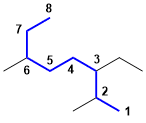 |
| Qu25: |
The longest chain including the alkene is C7 so a heptene. To give the alkene the lowest number, we need C2=C3 with an methyl group at C3. The double bond has stereochemistry, with the parent root chain being trans, so we have trans-3-methylhept-2-ene. (v1=AB, v2=E) |
 |
| Qu26: |
The ring containing the alkene is C6 therefore a cyclohexene. The alkene defines the numbering, with the first point of difference requiring that we define the alkene C with the methyl group attached as C1. Since we must number via the alkene, this means the ethyl group is at C5. Hence, 5-ethyl-1-methylcyclohexene. (v1=AB, v2=E) |
 |
| Qu27: |
The longest chain including the principal functional group (an acid chloride) is C4, so we have a butanoyl system, butanoyl chloride. (v1=C, v2=D) |
|
| Qu28: |
Naming of simple alkyl groups (v1=D, v2=C) |
 |
| Qu29: |
Substituted benzenes and ester naming : (v1=B, v2=C) |
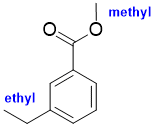 |
| Qu30: |
R/S stereochemistry
Chirality center is marked with a *. Priority of groups there is OH > C(CCC) > C(CCH) > H. (v1=B, v2=A) |
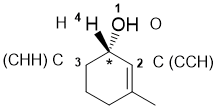 |
| Qu31: |
The bicyclic system has 8C and an alcohol so it is an octanol. The [3.2.1] indicates the number of C atoms in each link between the bridgehead carbons. Need to start to number from a bridgehead where the priority group (-OH) is located. (v1=A, v2=D) |
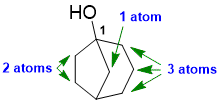 |



















